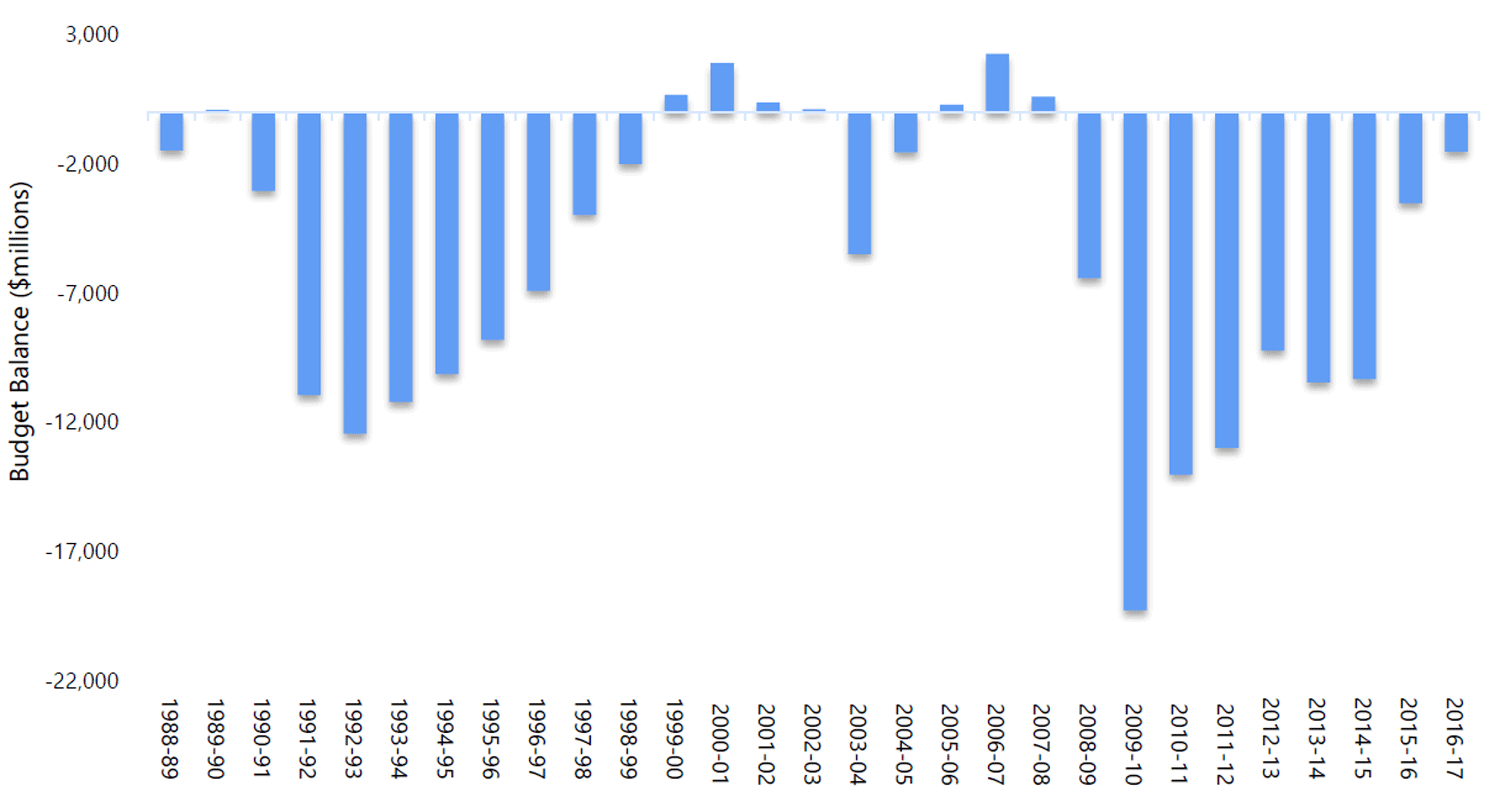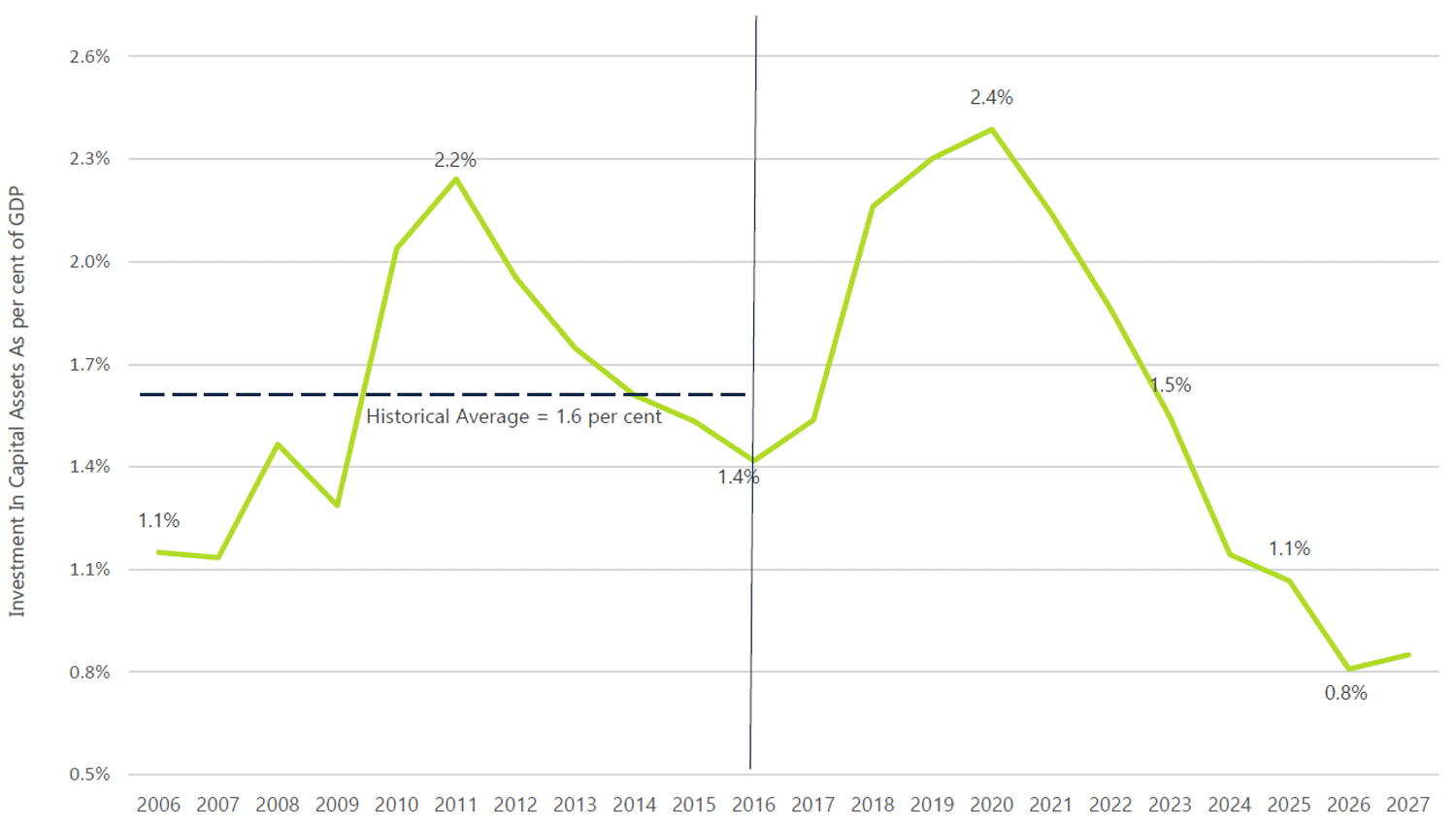The FAO projects that Ontario’s net debt will increase by $76 billion over the next five years to approximately $392 billion in 2021-22, resulting in the net debt-to-GDP ratio rising to 40.3 per cent.[1] In contrast, in the 2017 Budget, the Province projects a small decline in the net debt-GDP ratio to 36.3 per cent by 2021-22.
In the 2017 Budget, the government also restated its commitment to reduce the net debt-to-GDP ratio to its pre-recession level of 27 per cent. The Province projects that this 27 per cent target will be achieved by 2029-30, based on three key assumptions:
- on-going balanced budgets, on average, over the next 12 years[2];
- future capital spending as laid out in the long-term infrastructure plan; and
- a continuation of strong economic growth.
However, if any of these relatively optimistic assumptions fall short of expectations, the government’s 27 per cent debt-to-GDP target would not be achieved.
Achievement of 27 Per Cent Debt-To-GDP Target Based on Unlikely Assumptions

Note: AG recommended presentation based on FAO estimates of the pension adjustment.
Source: Ontario 2017 Budget and FAO
The government’s forecast for a gradual decline in the net debt-to-GDP ratio depends critically on achieving a string of balanced budgets on average over the next 12 years. Over the past thirty years, Ontario has rarely achieved successive surpluses or balanced budgets. In contrast to the 2017 Budget, the FAO continues to project a steady deterioration in the budget deficit over the next five years, due to moderating revenue growth combined with higher expenses.
Ontario has Rarely Achieved Balanced Budgets in Consecutive Years

Source: Ontario Budgets 1988-89 to 2017-18
The government’s debt reduction commitment is also linked to the Province’s 13-year, $190 billion infrastructure plan which includes significant reductions in capital investment in the 2020s. After peaking in 2019-20 at 2.4 per cent of nominal GDP, the Province is projecting capital spending to fall to just 0.8 per cent of GDP by 2027-28 – half of the historical average of 1.6 per cent.
Since the Province has made substantial investments in public sector assets (such as hospitals) over the last 10 years, some pullback is to be expected.[3] However, given the government’s focus on new and large transit and highway projects, it is likely that the Province will need to augment its capital plan and increase spending in the latter part of the next decade. Higher than planned capital spending in the future would add to the Province’s net debt, increasing the net debt-to-GDP ratio.[4]
Finally, the government’s debt-to-GDP projection relies on nominal GDP growing at an average pace of 4 per cent per year over the long-term.[5] However, nominal GDP growth has averaged just 3.6 per cent per year over the past 15 years, and given Ontario’s aging population and slower expected growth in its labour force, 4 per cent annual growth may prove to be too optimistic for the next decade.
Investment in Capital Assets as a Share of GDP to Decline Sharply in the 2020s

Source: Investment in Capital Assets, 2017 Infrastructure Update, Ministry of Infrastructure, FAO
Given the risks associated with the government’s assumptions, a fiscal plan that focuses only on achieving balanced budgets may not be enough to lower Ontario’s net debt-to-GDP ratio to 27 per cent by 2029-30.
Mario Angastiniotis
Senior Director
mangastiniotis@fao-on.org
David West
Chief Economist
dwest@fao-on.org
Financial Accountability Office of Ontario
2 Bloor Street West, Suite 900
Toronto, Ontario M4W 3E2
Media queries, contact: Kismet Baun, 416.254.9232 or email kbaun@fao-on.org.
[1] Based on the FAO’s application of the Auditor General’s recommended accounting treatment for pension assets - see the FAO’s ‘Economic and Fiscal Outlook, Spring 2017’. By comparison, based on the government’s accounting presentation, the FAO projects Ontario’s net debt will rise by $62 billion to roughly $365 billion by 2021-22 and that the net debt-to-GDP ratio will fall modestly to 37.5 per cent.
[2] This does not imply that the province necessarily has to achieve balanced budgets in each year. Alternatively, it could post balanced budgets on average, with some years in surplus and some in deficit.
[3] See Infrastructure Ontario’s list of major projects, http://www.infrastructureontario.ca/Major-Projects/, August 16, 2017.
[4] The government’s capital spending projection may also prove to be too conservative given a number of announced but unfunded initiatives including high-speed rail and subway expansion in Toronto.
[5] Ontario’s Long-Term Report on the Economy, Ministry of Finance, 2017
Achievement of 27 Per Cent Debt-To-GDP Target Based on Unlikely Assumptions
This chart shows historical and forecasted net debt-to-GDP ratio from 2010-11 to 2021-22 under three different bases: the FAO’s forecast based on the AG’s recommended presentation; the FAO’s forecast based on the government’s presentation; and the government’s forecast as presented in the 2017 Budget. The graph shows the FAO’s forecast of the ratio based on the AG’s accounting presentation rising over the outlook to 40.3 per cent by 2021-22, whereas the FAO’s forecast based on the government’s accounting presentation falls to 37.5 per cent by 2021-22. The government’s forecast as presented in the 2017 Budget, shows net debt-to-GDP declining to 36.3 per cent by 2021-22. The government forecast has been extended based on 2017 Budget data to show a decline to 26.8 per cent by 2029-30. The chart also shows historical and forecasted total net debt, based on both the AG’s and government’s accounting presentation.
Ontario has Rarely Achieved Balanced Budgets in Consecutive Years
This chart displays Ontario’s annual budget balance from 1988-89 to 2016-17. The chart shows that since 1988-89, Ontario’s annual budget balance has typically been in deficit. The province has rarely achieved successive surpluses or balanced budgets.
Investment in Capital Assets as a Share of GDP to Decline Sharply in the 2020s
This chart shows the province’s annual investment in capital assets as a share of nominal GDP from 2005-06 to 2027-28 based on the Province’s 13-year $190 billion infrastructure plan. The chart shows that after peaking in 2019-20 at 2.4 per cent of nominal GDP, the Province is projecting capital spending to fall to just 0.8 per cent of GDP by 2027-28 – half of the historical average of 1.6 per cent.







